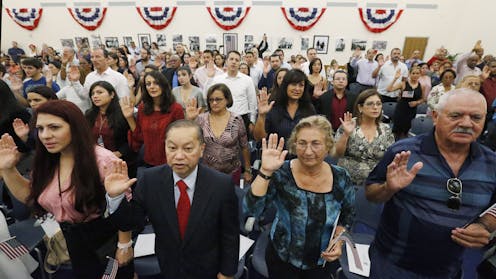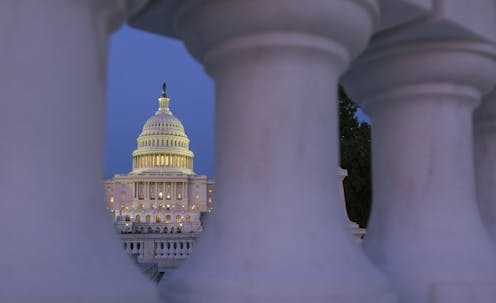How Arkansas is expanding Medicaid without actually expanding Medicaid
 'Premium assistance' at premium prices. Jonathan Bachman/Reuters
'Premium assistance' at premium prices. Jonathan Bachman/ReutersUpon the signing of the Affordable Care Act on March 23, 2010, the public was promised that all US citizens would receive health care coverage.
As Vice President Joe Biden put it at the signing of the bill: “You have turned, Mr President, the right of every American to have access to decent health care into reality – for the first time in American history.”
This changed in 2012 when the Supreme Court ruled in NFIB v Sebelius that states could opt out of expanding coverage for low-income uninsured adults under their Medicaid programs. Many poor adults, especially those without children, were ineligible for Medicaid before the Affordable Care Act came into effect.
As a result, many low-income Americans – about 4 million – still do not have access to health care coverage. Today, 23 states refuse federal money to pay for the cost of expanding coverage to many of their uninsured citizens.
In these states many people living in poverty receive no benefits under the ACA. They earn too much to qualify for Medicaid, but too little to be eligible for tax credits to subsidize private plans in the health care marketplace.
So what would have been a substantial redistribution of funding from the federal government to our poorest states has instead meant that many of our most vulnerable Americans are completely left out of the benefits of the ACA.
This happens, despite the fact that in many of these resistant states, the majority of their citizens favor accepting federal funding to expand Medicaid.
Resistant states
So why are some states refusing to expand coverage when the federal government will pay for most of it? Today the federal government is paying for 100% of the expansion, and will cover 90% from 2019 on. There are two answers.
First and foremost, this is a politically motivated response. The states refusing to take part in the expansion are all led by Republican governors, and many of these states have Tea Party leaning state legislators. There is adamant opposition towards expanding a government program. This is the case even though almost all the states contract out with private plans to provide coverage to Medicaid enrollees.
The second reason is that in many states adoption of the Medicaid expansion would mean a sizable proportion of the state’s population, up to a third, would be covered by Medicaid. This is because most states refusing to adopt the Medicaid expansion tend to be poorer states and have a history of setting very stringent eligibility levels for Medicaid.
To qualify for Medicaid a family or individual can earn up to 138% of the FPL – which isn’t very much money. In the past many poor states set their Medicaid eligibility levels very low. For example, Arkansas set its level at just 17% of the federal poverty level. The Medicaid expansion therefore represents a sizable increase in enrollment.
People are often surprised by how many Americans are eligible for Medicaid. Surprised because the federal poverty level (FPL) for a family of four is just US$23,850. The sad truth is that Americans are poorer than we are willing to admit, and that means a large proportion of people do need to rely on Medicaid for health-care coverage. And sadder still, the leaders in our poorest and reddest states do not want a third of their state residents relying on Medicaid.
Federal Medicaid funding
Despite political resistance to the Medicaid expansion, there are enormous financial pressures pulling these states towards adoption. Put simply, they are giving up a lot of federal money when they do not expand.
Many governors in resistant states argue that the federal government is untrustworthy and cannot be counted on to maintain their funding promise. And, not surprisingly, these governors do not want to invest state funds (10% of the cost of the expansion from 2019) to expand a program they don’t support.
The federal government has never reneged on its financial contribution in Medicaid’s 50-year history. In fact, since these states opted out of expanding Medicaid they have ended up spending more of their own money to cover the costs associated with medical care for the uninsured.
So, the pull towards adoption is strong and real, which helps explain why some Republican-controlled states, like Arkansas, have now adopted the Medicaid expansion. The irony is that the key to their adoption of the Medicaid expansion is a steadfast rejection of Medicaid.
The Arkansas model: an exercise in irony
Arkansas was the first and best example. The state adopted the “Private Option” or what is also called “Premium Assistance.” Under this model, the state allows all newly eligible Medicaid enrollees, an estimated 200,000 people, to choose a private health plan through the federally-run marketplace. The goal, as stated by the key designer of the Arkansas plan, Andrew Allison, is to expand private coverage and downsize Medicaid.
Under a waiver, the federal government allows Arkansas to pursue this approach and still receive federal matching funds. Similar “private” approaches are being pursued in Iowa, Ohio, Pennsylvania and New Hampshire. While this rhetoric allows designers to convince their Republican-dominated state legislators to move forward with the Medicaid expansion, it’s strange that in these same states marketplace contracting with private plans is considered a “government takeover.” This truly shows the power of political framing in real time.
There are other profound ironies. The Arkansas plan may end up being one of the more generous and costly programs in the country. Costly, because paying the cost of private insurance premiums is much higher than the equivalent of what the state paid Medicaid providers. But, generous, because Medicaid enrollees in Arkansas may have access to the same private plans, and their network of providers, as other middle-class Arkansans – something no other state has ever achieved.
Although Medicaid coverage has proven to be crucially important for providing access, it has also been considered a lower tiered program primarily because access is restricted to a relatively small set of providers who primarily take care of low-income uninsured and those with public insurance. The Arkansas approach may break down that two-tiered system. If so, the private sector will be lauded, while the substantial amount of public federal funding, which fuels this new “private option” will remain hidden from view.
Colleen Grogan receives funding from Robert Wood Johnson Foundation to organize bi-partisan workshops on the implementation of the ACA to help improve communication between researchers and practitioners. Any other grants have been related to academic research on the Medicaid program.


















